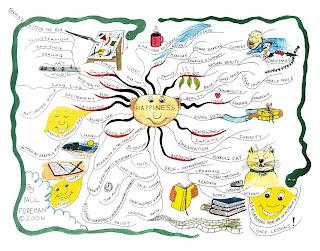 |
| The "We've Won It" supplement papers comes together with the "Terror Bombs Explode Across London" Evening Standard for free. |
 |
| A ragged, old man sitting on the pavement while looking upon a nicely dressed young lady. |
 |
| Old vs New: The Trinity Church in Boston. |
Juxtaposition is the act of placing two unrelated objects together to indicate a relationship between them. Stimulation of creative thinking occurs when two contrasting objects are in close proximity. The analogy of the juxtaposed subjects can be categorized into two - metaphor and simile.
Metaphor is a figure of speech that uses one thing to mean another and makes a comparison between the two. For example, "All the world's a stage" is a metaphor from a play written by Shakespeare. It compares the world to a theatre stage and life to a play (of seven stages).
Simile is pretty much the same as metaphor, but the key to their difference is that simile uses the conjunctions, "like" or "as", while metaphor connects the two subject directly.
Metaphor: "All the world's a stage,"
Simile: "The whole world is like a theatre stage."
________________________________________________________________
The tasks this week was rather fun, because really random and odd ideas were conjured thanks to entire class juxtaposing almost everything.
Task 1
Firstly, we were given two lists of words, and we had to choose three pairs of numbers (00 to 99).
 |
| Click to enlarge |
I picked three pairs of numbers and ended up with these combinations:
i) Flower & Root
ii) Ice & Mountain
iii)Duck & Rain
Then, we built sentences using these words, and with those sentences, we illustrate it out using our imagination. The fourth part, we had to draw out the combination of words instead of the sentence.
i) flower root
ii) ice mountain
iii) duck rain
Task 2
We were asked to choose two animals and combine them together, forming a new species of animal. Their characteristics need to be merged, but it has to be impossible for them to survive on Earth (land creature with sea creature).
This is a seahorse. Literally. It is a mutated horse with the body of a real seahorse. Horses are grazing animals while seahorses consume tiny crustaceans and shrimps, invertebrates and small fishes. Although they have similar physical features such as their long, nozzle-like "faces", almost everything about them - their breathing mechanism, reproductive system etc - are different.
Task 3
 |
| Candle vs Life |
With a flame so bright you outshine all.
To give so much, you burn from the core,
Time after time, others still ask for more.
Life's glory so brief, you were an untold legend,
Insignificant being, your death was hastened.
A fickle light towards the end,There is nothing before that you can mend.
 |
| Ice cream vs Pain |
Sweet and silky, freezing cold,
A scoop or more for young and old.
Chocolate, vanilla, strawberry and mint,
Every flavour with a different tint.
A spoonful or two can be delightful,
But have too much and it'll get frightful.
What's more irresistible to a child with cavities,
Than cold hard cream with flavours of candies?
 |
| Chilli vs Love |
Your love is hot and dangerous,
A taste of you makes me delirious.
The trace of your lips like fire,
They are all my heart's desire.
Being with you it's always summertime,
Feisty, erotic, yet so sublime.
You are my greatest temptation,
Loving you is a sultry sensation.







